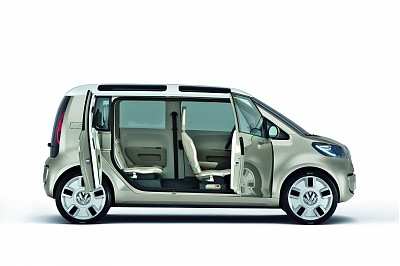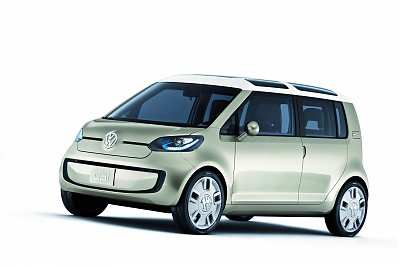|
| ||||
|
The Volkswagen Space Up! Blue - Clean Drive Revolution "Made in Germany"
16th November, 2007 | |||
|
Volkswagen presents the first car in the world with high-temperature fuel cell Space Up! Blue covers downtown distances with pure battery drive. Powertrain revolution in California: Volkswagen is presenting the Volkswagen Space-Up! Blue concept car at the Los Angeles Motor Show (16th to 25th November, 2007) as a world exclusive - a compact, self-confident zero emissions van in the style of the legendary Volkswagen Samba Bus. On board: the world's first high temperature fuel cell and an array of twelve lithium-ion batteries. When the electric motor 45 kW of the Volkswagen Space-Up! Blue is driven exclusively by battery, a range of approximately 105 kilometres is possible - enough to handle nearly all distances in downtown areas. In the scenario of tomorrow's world, the four-seat Volkswagen is advancing to become the ideal vehicle for anyone who wants to drive - completely emission-free - to work, recreation, school or university or just shopping. Energy is "refuelled" either via an electrical outlet or by the Volkswagen high-temperature fuel cell. In the latter case, the car's range is extended an additional 250 kilometres (approximately). This makes it possible to drive approximately 355 kilometres on a single "energy charge". Aside from this, the micro van utilises another energy source: the sun. And indeed with a large solar panel on the roof, it supplies up to 150 Watt of energy that is also fed into the battery. With its new high temperature fuel cell (HT-FC) Volkswagen is introducing a system that represents a turning point in research on fuel cells for mass production. That is because, the HTFC offers crucial advantages compared to all other fuel cell systems: considerably lower weight, significantly greater everyday utility, substantially lower price and, therefore, clearly the better chances of becoming a reality someday as a mass produced technology. The high temperature fuel cell was developed at a dedicated research centre founded by Volkswagen in Germany. With its concept car being shown in Los Angeles, Europe's most successful car producer is introducing the third variant of its "New Small Family" within just two months. Like the city specialist, the Up!, already introduced at the 2007 Frankfurt Motor Show (IAA) and the Space Up! presented in Tokyo, the Volkswagen Space-Up! Blue is a small space wonder too. Over a length of just 144.9 inches, a height of 61.8 inches and a width of 64.2 inches, it offers the space of a considerably larger vehicle. The clever space concept of the Volkswagen Space-Up! Blue - which is 1,090 kilogrammes "light" despite the fuel cell and batteries - is largely due to the layout of the powertrain. Its emission-free electric motor operates - as did the engines of the Beetle and the Bulli (Kombi) at one time - in the rear. Also housed in the rear, under the rear seat to be exact, are the lithium-ion batteries. The high temperature fuel cell, on the other hand, is located at the front of the car. Volkswagen Space-Up! Blue is the third concept car of the New Small Family by Volkswagen The Volkswagen Space-Up! Blue - with its four roof windows - is reminiscent of the Samba Bus of the 1950s. However, at a length of 144.9 inches the contemporary concept car is almost 23.6 inches shorter than the cult bus of that era. And so the "new one" is anything but a retro version of the "old one". Nonetheless, the two vans are certainly 'kindred spirits', and this goes beyond sharing the windows in the roof. For example, their designs both incorporate butterfly doors with opposing hinges and a motor layout in the rear. Electric motor and battery Exclusively driven by battery, the motor powers the Volkswagen Space-Up! Blue over a range of approximately 105 kilometres. By comparison: a hybrid car in pure electric drive mode - i.e. with energy stored in the battery - can travel just two kilometres on average. The combustion engine must kick in again before this distance is driven. Consequently, the Volkswagen Space-Up! Blue represents a conceptual approach, reaching beyond hybrid technology, for operating the automobile just by battery, especially in urban areas. However, a prerequisite for this technology are durable and affordable lithium-ion batteries with high charge capacities. With their help, transportation could become "electrified" - i.e. converted from combustion engines to electric motors - in a stepwise manner, initially in the big cities. The infrastructure needed for this is simple: electrical outlets! Step by step, public and private parking spaces and parking garages would have to be equipped with "electric service pumps" to offer charging capabilities. At night, vehicles like the Volkswagen Space-Up! Blue could take advantage of night-time rates for electrical power - which are often much lower in many countries - to "fill up their tanks". The fact is: today the Space Up! Blue concept car could already handle average daily driving distances in pure battery mode - without a fuel cell. High temperature fuel cell The fuel cell utilises hydrogen (H2) to obtain electrical energy. Two safety tanks integrated in the underbody store up to 3.3 kilogrammes of compressed hydrogen. This quantity is enough to operate the electric motor over a distance of 250 kilometres (approximately). With fully charged battery and full hydrogen tanks, the theoretical range is a full 355 kilometres (approximately). So theoretically, even an excursion from the Los Angeles Motor Show to picturesque Santa Barbara and back would be feasible without an energy recharge. These are distances that demonstrate how cars with electric motors plus fuel cell are capable of more than just city driving. Aside from the fact that hydrogen would have to be produced in sufficient quantities by regenerative energy, there is another serious problem: All fuel cells known to date - that is low temperature fuel cells - need to operate over a very specific temperature range. If the temperature rises too much, energy recovery is brought to a standstill. That is why all of these fuel cell designs have relatively large and likewise complex cooling and humidification technologies. This is precisely where the high temperature fuel cell developed by Volkswagen comes in. It eliminates the numerous disadvantages of previously known low temperature fuel cells (LTFCs). A new high-temperature membrane and electrodes specially designed for this membrane enable significantly more compact, affordable and efficient fuel cell systems, as shown on the Space Up! Blue concept car in Los Angeles. Working together with its custom designed electrodes, the high-temperature membrane can be "driven" over a temperature range of up to 160 degrees Celsius. An average operating temperature of 120°C is planned for vehicle operation and, indeed, without requiring supplemental humidification. Therefore - in contrast to the LTFC - it is sufficient to implement a much simpler cooling and water management system. This reduces space requirements, weight and costs significantly! Space concept Exterior design The colour of choice for the Volkswagen Space-Up! Blue's exterior is a cool champagne metallic tone called "Waterborne". The roof distinguishes itself through its white varnish resembling the Samba Bus, the panorama windows integrated on the sides and the solar panel. Front end: Distinguishing the front end of the "New Small Family" are the headlamps that take an inward diagonal line, between them the horizontally integrated air inlets (minimised aperture optimises aerodynamics), the VW logo arranged on the front bonnet (as the only exterior detail kept in chrome) and the smooth-surfaced bumper with a lower segment. Side profile: On its sides, the concept car - like the Samba bus in earlier days - exhibits a long extended window section, additional roof windows and a clearly distinctive, powerful C-pillar whose form is typical of Volkswagen. The A-pillar is positioned far forward. The space between the A and C pillars is spanned by the line of butterfly doors with opposing hinges. Both the front and rear doors are opened by door handles at the height of the imaginary B pillars. Since the doors open in opposition and extend across nearly the entire space between the wheel housings - i.e. the entire sill length - all four seating positions are exceptionally convenient to access. A key concept here is wheel housings: Hidden under them are the self-confident and large 18-inch wheels with low rolling resistance tyres sized 165/50. Distinctive in this area are the short front and rear overhangs. The front overhang, from the axle hub to the outer skin of the bumper measures just 53 centimetres; in the rear it is 59 centimetres. The result: crisp proportions. Rear end: Also unmistakable are the design features of the rear end. Take the example of the rear door: It fills out practically the entire car area above the bumper. Similar to the smaller Up!, the door - split 1/3 to 2/3 - consists of a transparent material. Integrated beneath it are the taillights. Fully opened, the door offers a cargo width of 101 centimetres. The bumper itself was designed to match its counterpart at the front end. Thanks to the wide track width of 1.42 metres, the outer edges of the wheels line up with the wheel housings. The effect is that the entire vehicle width of 1.63 metres seems to consist of axles plus tyres and wheels. Meanwhile, the only details that boldly jump outside of the vehicle width are the round-shaped outside mirrors. 
Interior design But the show-stoppers are the materials used: most surfaces are made of recycled materials. With more vigour than ever, a material world both very technical and very noble was provided. The instrument panel and the door coverings are made of organic plastic (biopolymers). This composite material is made of wood, plastics and admixed additives and its pellet impression went straight into the interior design. Interior concept With the exception of the driver's seat, all seats can also be folded and removed. If the seats are "only" folded, this provides a level cargo area with a capacity of up to 1,005 litres. With four people on board, cargo capacity up to the height of the window sill is still 220 litres. User interface Utilising the menu was retooled and reorganised so that people without computer science education can operate the system. The engineers intentionally separated "display" and "control" levels from one another. Always shown on the screen is a control bar with standard functions such as climate control and audio volume control. Developers packaged functions of other higher-order systems - navigation, telephone, radio, images, films, etc. - on a display level that has been referred to internally as the "main menu carousel" - a type of virtual carousel. It consists of the icons of different system functions (telephone, navigation, etc.). When the user touches the "main menu carousel" it can be rotated by touch screen. Visually, this control is just as spectacular as it is intuitive. When the desired function appears on the main menu carousel - such as the telephone - the user just needs to move his or her hand to the display to switch to the telephone menu thanks to proximity sensor technology. Just like on the two members of the New Small Family already presented, this fact applies to the Volkswagen Space-Up! Blue too: the new type of user control is fun, easy to understand in any cultural environment and very safe. That is precisely what is typical of Volkswagen. | ||||
ABN 47106248033 |
 |
All rights reserved. |
